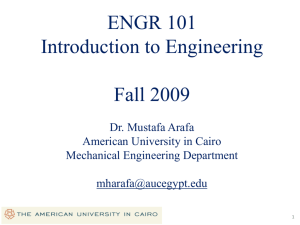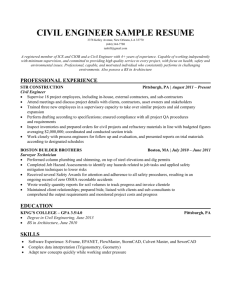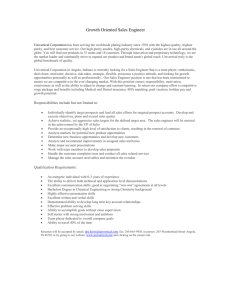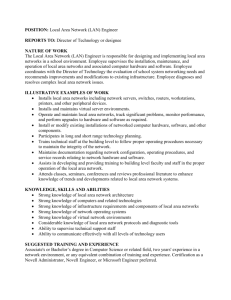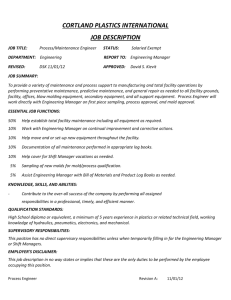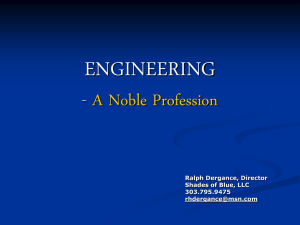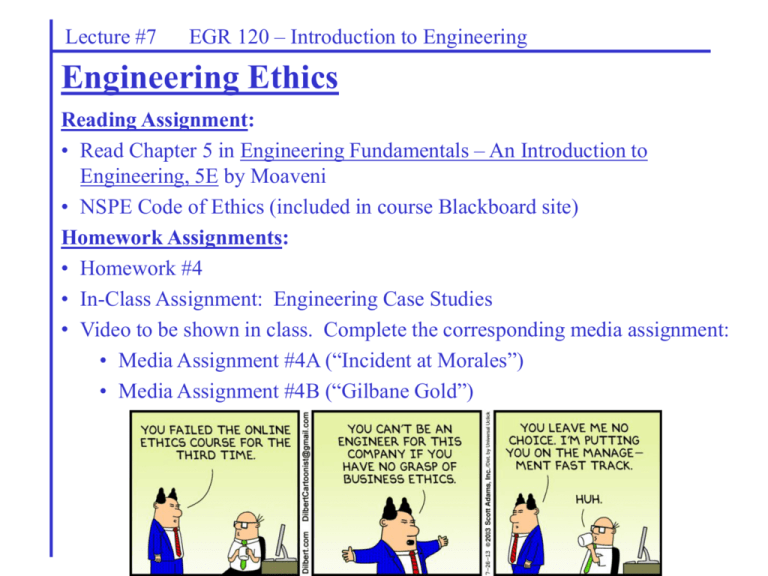
Lecture #7
EGR 120 – Introduction to Engineering
Engineering Ethics
Reading Assignment:
• Read Chapter 5 in Engineering Fundamentals – An Introduction to
Engineering, 5E by Moaveni
• NSPE Code of Ethics (included in course Blackboard site)
Homework Assignments:
• Homework #4
• In-Class Assignment: Engineering Case Studies
• Video to be shown in class. Complete the corresponding media assignment:
• Media Assignment #4A (“Incident at Morales”)
• Media Assignment #4B (“Gilbane Gold”)
2
Lecture #7
EGR 120 – Introduction to Engineering
Ethical Conflicts
Engineers might be pulled in different directions:
Personal conscience
Needs of society
Needs of employer
Professional ethics
3
Lecture #7
EGR 120 – Introduction to Engineering
FE Exam Questions on Engineering Ethics
Recall that the Fundamentals of Engineering (FE) Exam includes
questions on engineering ethics. This exam uses a multiple-choice
format and might include problems similar to those shown below.
FE-Style Ethics Question #1:
When is the receipt of compensation from more than one party
for the same project ethical?
A) Never
B) When the total of all compensation received does not exceed
“reasonable” compensation for the type of work performed
C) Always
D) When all parties involved know about and agree to the
arrangement
What section(s) of the NSPE Code of Ethics might apply to this
situation?
4
Lecture #7
EGR 120 – Introduction to Engineering
FE-Style Ethics Question #2:
When may professionals make political donations?
A) At no time
B) If it is not for current, past, or future influence or favors
C) If all donations are made as an individual and do not
represent a firm or entity
D) Only below specified amounts
What section(s) of the NSPE Code of Ethics might apply to this
situation?
5
Lecture #7
EGR 120 – Introduction to Engineering
FE-Style Ethics Question #3:
In the event of an ethical conflict, to whom does the
professional hold the least ethical responsibility?
A) The employer
B) The client
C) The consumer
D) Society
What section(s) of the NSPE Code of Ethics might apply to this
situation?
6
Lecture #7
EGR 120 – Introduction to Engineering
FE-Style Ethics Question #4:
“Whistle-blowing” is
A) An ethical practice
B) An illegal practice
C) An unethical practice
D) A career-enhancing practice
What section(s) of the NSPE Code of Ethics might apply to this
situation?
7
Lecture #7
EGR 120 – Introduction to Engineering
Case Studies in Engineering Ethics
“Case studies” are often used in engineering ethics to present
scenarios where engineers might find themselves in ethical
dilemmas. These case studies give the student a chance to think
about how he or she might respond in a similar situation and to see
how the NSPE Code of Ethics might provide some guidance.
A related homework assignment presents several case studies for
discussion.
Some examples are also presented in the following slides.
Most of the examples are from the textbook.
8
Lecture #7 EGR 120 – Introduction to Engineering
Case Study #1:
Facts: You are a Chemical Engineer working for the Environmental Protection
Agency (EPA) responsible for investigating motor vehicle engine pollution control
standards. You have found that one group of engines produced by a major
automobile manufacturer for the current model of automobiles now being sold
exceeds pollution control standards. The manufacturer is notified to determine the
direction of corrective recall action.
The manufacturer submits a plan to you proposing to leave the current engines
alone, but to make sure that next year’s models would be especially designed for
lower emissions to make up for the excessive levels emitted by the current models.
The manufacturer claims that their plan would save them $11.8 million and in
addition would save the owners $25.8 million in fuel costs because the repairs
necessary to improve emission performance would increase fuel consumption.
The proposal from the manufacturer comes to you for your recommendation.
Questions:
•
What would you recommend?
an acceptance of manufacturer’s proposal
an immediate recall action
•
What section(s) of the NSPE Code of Ethics might apply to this situation?
9
Lecture #7
EGR 120 – Introduction to Engineering
Case Study #2:
Facts: Assume that you are an Engineer working for a high-tech
company that makes extensive use of trichloroethylene (TCE), an
industrial solvent that causes cancer and affects the liver, kidneys,
and nervous system. Your company has established a storage site
and you are responsible for designing a monitoring a system for
detecting possible leakage. You submitted your design to your
supervisor for approval two months ago, but to date have not
received any indication that the corrective design solution has been
reviewed. Two weeks ago when you questioned your supervisor
about the status, he said it was still in the “approval cycle.”
Questions:
• What would you do?
• What section(s) of the NSPE Code of Ethics might apply to this
situation?
10
Lecture #7
EGR 120 – Introduction to Engineering
Case Study #3: 2002 Milton F. Lunch Ethics Contest
Facts: Engineer A is a graduating senior with excellent credentials from X
University. Engineer A has had a series of job interviews with engineering
companies from around the U.S. Following interviews with several
industrial companies, Engineer A decides to accept an offer with ABC
Incorporated located in his hometown of Townville and plans to notify
ABC the following week. In the interim period, Engineer A receives a call
from Engineer B, an executive with XYZ Incorporated, a potential
employer with whom Engineer A interviewed. On behalf of XYZ, Engineer
B offers Engineer A (at XYZ’s expense) a chance to visit XYZ’s
headquarters in Mountainville, a city located near a resort area following
Engineer A’s graduation. Engineer A had earlier decided he would not
accept a position with XYZ if offered a position by ABC, because Engineer
A wanted to live near Townville to be close to family and friends, and also
because ABC provided better long-term professional opportunities.
(continued)
© 2011 Cengage Learning Engineering. All Rights Reserved.
11
Lecture #7
EGR 120 – Introduction to Engineering
Case Study #3: (continued)
Facts (continued): However, after receiving the call from XYZ, Engineer
A decides to accept the invitation to visit XYZ's headquarters and combine
the trip with a post-graduation vacation, believing that the visit to XYZ
will broaden Engineer A’s knowledge of the employment market, as well
as future professional opportunities with XYZ. A week after the trip,
Engineer A calls ABC and informs the company that he will accept the
position with ABC.
Questions:
• Was it ethical for Engineer A to accept the invitation to visit XYZ
headquarters?
• What section(s) of the NSPE Code of Ethics might apply to this
situation?
© 2011 Cengage Learning Engineering. All Rights Reserved.
12
Lecture #7
EGR 120 – Introduction to Engineering
Case Study #4: 2003 Milton F. Lunch Ethics Contest
Facts: Individual A is involved in a vehicular accident during
which another individual, Individual B, is killed. During the police
investigation, the police determined and recommended to
prosecutors that the matter should be converted from a civil matter
to a criminal prosecution, and Individual A is charged with
homicide. As part of the prosecutor’s investigation, the prosecutor
(Prosecutor C) retains Engineer D (an engineering expert) to review
the record and provide a supporting forensic report and testimony in
the prosecution of Individual A. Following Engineer D’s extensive
review of the record, Engineer D finds technical evidence to
demonstrate that the cause of the accident was non-criminal and
determines that he cannot support the prosecution’s theory that
Individual A’s actions support a criminal prosecution.
© 2011 Cengage Learning Engineering. All Rights Reserved.
13
Lecture #7
EGR 120 – Introduction to Engineering
Case Study #4: (continued)
Facts (continued):
Learning of Engineer D’s determination, Prosecutor C continues the
prosecution of Individual A, and does not call Engineer D as a
witness at trial. The trial ends in a hung jury, and the case is
expected to be retried in the near future.
Questions:
• What are Engineer D’s ethical obligations under the facts and
circumstances?
• What section(s) of the NSPE Code of Ethics might apply to this
situation?
© 2011 Cengage Learning Engineering. All Rights Reserved.
14
Lecture #7
EGR 120 – Introduction to Engineering
Case Study #5: Confidentiality of Engineering Report: Case No. 82-2
Facts: Engineer A offers a home owner inspection service,
whereby he undertakes to perform an engineering inspection of
residences by prospective purchaser. Engineer A performed this
service for a client (husband and wife) for a fee and prepared a
one-page written report, concluding that the residence under
consideration was in generally good condition requiring no major
repairs, but noting several minor items needing attention. Engineer
A submitted his report to the client showing that a carbon copy was
sent to the real estate firm handling the sale of the residence.
© 2011 Cengage Learning Engineering. All Rights Reserved.
15
Lecture #7
EGR 120 – Introduction to Engineering
Case Study #5: (continued)
Facts (continued):
They also complained that Engineer A acted unethically in
submitting a copy of the report to any others who had not been
a party to the agreement for the inspection services.
Questions:
• Did Engineer A act unethically in submitting a copy of the home
inspection report to the real estate firm representing the owners?
• What section(s) of the NSPE Code of Ethics might apply to this
situation?
© 2011 Cengage Learning Engineering. All Rights Reserved.
116
Lecture #7
EGR 120 – Introduction to Engineering
Case Study #6: Gift Sharing of Hotel Suite: Case No. 87-4
Facts: Engineer B is director of engineering with a large
governmental agency that uses many engineering consultants.
Engineer A is a principal in a large engineering firm that performs
services for that agency. Both are members of an engineering
society that is conducting a two-day seminar in a distant city. Both
plan to attend the seminar, and they agree to share costs of a twobedroom hotel suite in order to have better accommodations.
Questions:
• Was it ethical for Engineer A and B to share the hotel suite?
• What section(s) of the NSPE Code of Ethics might apply to this
situation?
© 2011 Cengage Learning Engineering. All Rights Reserved.
17
Lecture #7
EGR 120 – Introduction to Engineering
Case Study #7: Credit for Engineering Work-Design Competition: Case No. 92-1
Facts: Engineer A is retained by a city to design a bridge as part of an
elevated highway system. Engineer A then retains the services of Engineer
B, a structural engineer with expertise in horizontal geometry, super
structure design, and elevations to perform certain aspects of the design
services. Engineer B designs the bridge’s three curved welded plate girder
spans, which were critical elements of the bridge design. Several months
following completion of the bridge, Engineer A enters the bridge design
into a national organization’s bridge design competition. The bridge
design wins a prize. However, the entry fails to credit Engineer B for his
part of the design.
Questions:
• Was it ethical for Engineer A to fail to give credit to Engineer B for his
part in the design?
• What section(s) of the NSPE Code of Ethics might apply to this
situation?
© 2011 Cengage Learning Engineering. All Rights Reserved.
18
Lecture #7 EGR 120 – Introduction to Engineering
Case Study #8: Services - Same Services for Different Clients: Case No. 00-3
Facts: Engineer A, a professional engineers, performs a traffic study for
Client X as part of the client’s permit application for traffic flow for the
development of a store. Engineer A invoices Client X for a complete
traffic study. Later, Client X learns that part of the traffic study provided
by Engineer A to Client X was earlier developed by Engineer A for a
developer, Client Y, at a nearby location and that Engineer A invoiced
Client Y for the complete traffic study. The second study on a new project
for Client X utilized some of the same raw data as was in the report
prepared for Client Y. The final conclusion of the engineering study was
essentially the same in both studies.
Questions:
• Was it ethical for Engineer A to charge Client X for the complete traffic study?
• What section(s) of the NSPE Code of Ethics might apply to this
situation?
© 2011 Cengage Learning Engineering. All Rights Reserved.
19
Lecture #7
EGR 120 – Introduction to Engineering
Case Study #9: Use of Alleged Hazardous Material in a
Processing Facility: Case No. 99-11
Facts: Engineer A is a graduate engineer in a company’s manufacturing
facility that uses toxic chemicals in its processing operations. Engineer A’s
job has nothing to do with the use and control of these materials. A
chemical called “MegaX” is used at the site. Recent stories in the news
have reported alleged immediate and long-term human genetic hazards
from inhalation of or other contact with MegaX. The news items are based
on findings from laboratory experiments, which were done on mice, by a
graduate student at a well-respected university’s physiology department.
Other scientists have neither confirmed nor refuted the experimental
findings. Federal and local governments have not made official
pronouncements on the subject. Several colleagues outside of the company
have approached Engineer A on the subject and ask Engineer A to “do
something” to eliminate the use of MegaX at the processing facility.
© 2011 Cengage Learning Engineering. All Rights Reserved.
20
Lecture #7
EGR 120 – Introduction to Engineering
Case Study #9: (continued)
Engineer A mentions this concern to her manager who tells
Engineer A, “Don’t worry, we have an Industrial Safety
Specialist who handles that.” Two months elapse and MegaX
is still used in the factory. The controversy in the press
continues, but since there is no further scientific evidence pro
or con in the matter, the issues remain unresolved. The use of
the chemical in the processing facility has increased and now
more workers are exposed daily to the substance than was the
case two months ago.
Questions:
• Does Engineer A have an obligation to take further action under
the facts and circumstances?
• What section(s) of the NSPE Code of Ethics might apply to this
situation?
© 2011 Cengage Learning Engineering. All Rights Reserved.
21
Lecture #7
EGR 120 – Introduction to Engineering
Case Study #10: Advertising – Statement of Project Success:
Case No. 79-6
Facts: Engineer A published an advertisement in the classified
section of a daily newspaper under the heading, “Business
Services,” which read in full: “Consulting Engineer for Industry.
Can reduce present process heating fuel consumption by 30% to
70% while doubling capacity in same floor space. For more
information contact Engineer A, telephone 123-456-7890.”
Questions:
• Was Engineer A’s advertisement ethical?
• What section(s) of the NSPE Code of Ethics might apply to this
situation?
© 2011 Cengage Learning Engineering. All Rights Reserved.
22
Lecture #7
EGR 120 – Introduction to Engineering
Case Study #11: Using Technical Proposal of Another Without
Consent: Case No. 83-3
Facts: Engineer B submitted a proposal to a county council following an
interview concerning a project. The proposal included technical
information and data that the council requested as a basis for the selection.
Smith, a staff member of the council, made Engineer B’s proposal
available to Engineer A. Engineer A used Engineer B’s proposal without
Engineer B’s consent in developing another proposal, which was
subsequently submitted to the council. The extent to which Engineer A
used Engineer B’s information and data is in dispute between the parties.
Questions:
• Was it unethical for Engineer A to use Engineer B’s proposal without
Engineer B’s consent in order for Engineer A to develop a proposal that
Engineer A subsequently submitted to the council?
• What section(s) of the NSPE Code of Ethics might apply to this
situation?
© 2011 Cengage Learning Engineering. All Rights Reserved.
23
Lecture #7
EGR 120 – Introduction to Engineering
Video:
One of the two following videos will be shown during class.
• “Gilbane Gold” (25 minutes) – Complete Media Assignment #4B
• “The Incident at Morales” (36 minutes) - Complete Media
Assignment #4A
Complete the worksheet for the video shown and submit it on the
date assigned by the instructor.

